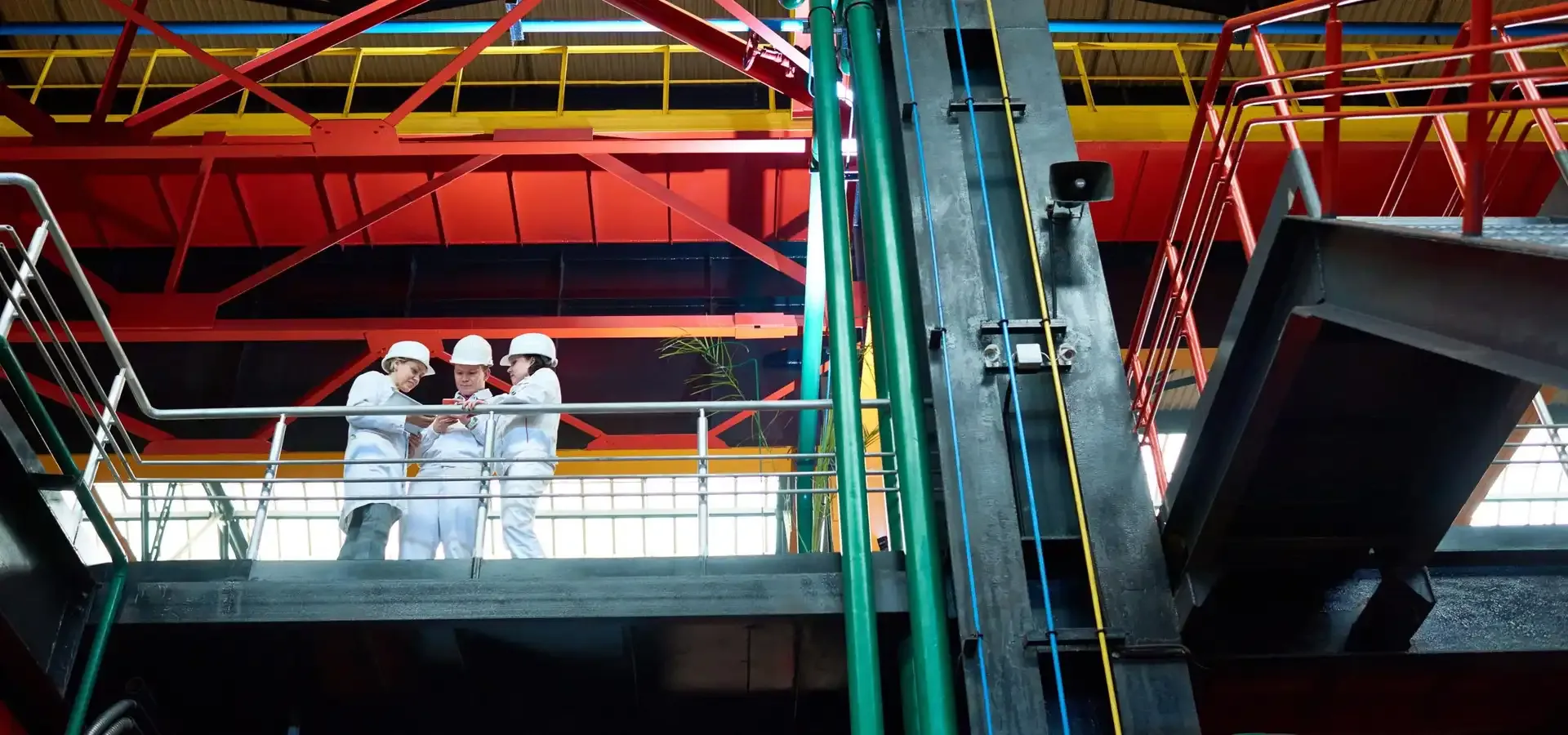Services
SERVICES
SOLUTIONS
TECHNOLOGIES
Industries
Insights
TRENDING TOPICS
INDUSTRY-RELATED TOPICS
OUR EXPERTS

November 25, 2025
IoT devices and sensors collect real-time data from a construction site about equipment status, work progress, environmental parameters, and site safety and transfer them to a cloud-based platform for further analysis. This enables project managers to track a wide range of project metrics in real-time and instantly share it with contractors and subcontractors, providing better visibility into the project's progress and enabling more informed decision-making.
Construction crew managers and security specialists use real-time information, like equipment status, worker location, assets movement, environmental conditions, and more, collected from smart sensors, RFID tags, GPS trackers, and connected equipment to quickly adjust work schedules, track the movement of assets and workers, or suspend operations if violations are detected. Thus, continuous monitoring of construction operations enables project managers to make informed decisions and promptly respond to incidents without the need for a physical presence on site.
IoT sensors installed on construction sites collect data on the building’s structural parameters, geotechnical, and climate data and send them to a digital twin software that generates a virtual prototype of the constructed building. Engineers and contractors use this model to monitor the site’s state and construction progress in real-time, compare it to design specifications, and run simulations to predict potential issues. This allows construction teams to detect and resolve design issues early and ensure a shared understanding of the project’s goals and progress among all stakeholders.
Incorporating IoT sensors into vehicles and machinery enables construction companies to track the location, performance, and fuel levels of their fleet and construction equipment in real-time. By analyzing this data, managers сan plan asset maintenance in advance, detect fuel consumption optimization opportunities, allocate equipment more effectively, and improve route planning to reduce unnecessary wear and tear, minimize idle time, and lower operational and repair costs.
Cranes, bulldozers, and escalators equipped with IoT sensors can collect operational data, including their condition, movement, and operational parameters, which allows managers to monitor their performance, predict maintenance needs, and optimize usage schedules. When smart construction equipment is enhanced with computing capabilities in addition to sensors, it can be remotely controlled by the operators to perform their intended tasks autonomously, saving companies money and enhancing worker safety.
With IoT sensors, RFID tags, and GPS trackers installed on pallets and across warehouses, construction companies can track the location, storage conditions, and usage of materials in real-time for instant identification of material shortages and prevention of theft. By analyzing this data, companies can also optimize supply chain and warehousing processes through data-driven demand forecasting, improved logistics coordination, and reduced idle inventory, as well as detect deviations between planned and actual material usage, optimizing inventory replenishment to prevent project delays.
Construction companies can use smart cameras, motion sensors, and drones to monitor and maintain the overall job site security around the clock. These devices record activity on the work site in real time and send this data to the analytics platform, where computer vision algorithms can detect suspicious behavior. In the event of a confirmed intrusion or potential theft, the IoT analytics system immediately alerts security teams, which ensures a rapid response and prevention of material losses.
Wearable devices, like smart helmets, boots, and vests, can collect workers' health data in real-time, including heart rate, body temperature, fatigue levels, posture, and location. Processing this data, the IoT system alerts managers of potential worker health risks, such as heat stress, exhaustion, or danger so that they can take immediate preventive actions, reducing the number of worker injuries or illnesses.
IoT sensors installed on construction sites collect real-time data on various environmental parameters, such as temperature, humidity, noise and toxic gas levels, and vibration. This data is transmitted to an analytics solution that quickly detects the risk of hazards, such as gas leaks, excessive dust, or sudden temperature fluctuations, and alerts workers about them, thereby helping ensure high construction site safety.
IoT systems enable the automated control of lighting, heating, ventilation, and air conditioning (HVAC) systems at a work site based on its occupancy or the time of day and other aspects which helps optimize energy consumption. Also, the IoT data analytics engine helps analyze energy consumption data, identify energy inefficiencies, and come up with tailored energy-saving measures, helping construction agencies lower their operating costs.
Smart containers installed on construction sites can track material types, usage, disposal patterns, and waste levels in real-time. When sensors are integrated with AI-based sorting systems, they can detect smoke, combustion, or hazardous materials inside a container and notify dispatchers to mark the container as “high priority” and arrange its immediate pickup or isolate the waste area until the issue is resolved. This prevents waste overfilling, safety hazards, and pollution of recyclables while improving waste sorting efficiency.
IoT-enabled devices and sensors installed across the on-site water and sewage infrastructure, such as pipelines, tanks, and drainage systems, provide real-time monitoring of water usage, temperature, level, and flow. By collecting and analyzing this data, construction companies can quickly detect leaks and inefficiencies within their water systems and take the necessary actions for more effective use of water resources on their work sites.
IoT systems collect real-time information about assets and resources, construction progress, and worker productivity. This helps construction companies identify any issues early on and take the necessary actions to resolve them efficiently, ensuring their uninterrupted operations.
IoT devices and sensors collect real-time data on the status of equipment and work sites, simplifying collaboration between project managers and subcontractors and enabling them to quickly make informed decisions about the construction process.
With IoT, companies can gain in-depth and real-time visibility into their resource usage and asset performance. By analyzing this data, companies can optimize resource allocation and plan equipment maintenance in advance to prevent costly equipment breakdowns and unplanned downtime, lowering their operational costs.
Connected wearable devices monitor the health of workers, while IoT-enabled sensors embedded into the equipment can alert managers about potentially hazardous conditions on construction sites, such as gas leaks or extreme temperatures. This way, IoT helps construction companies prevent accidents and maintain safe working conditions for their employees.
Through remote work site monitoring with the help of surveillance cameras, motion sensors, and RFID and GPS technologies, construction companies can effectively oversee the facility’s and valuable assets’ safety in real-time, thereby reducing the risks of theft and other issues.
IoT-enabled sensors can track energy consumption, equipment status, and environmental parameters in real-time. This data helps optimize transportation routes to reduce fuel use, extend equipment lifespan via predictive maintenance, and enhance energy efficiency.
The implementation of the Internet of Things at construction sites is often associated with various challenges which can prevent companies from realizing the full value of the technology. To avoid this, organizations need to get a deep understanding of the most common IoT implementation problems and proven ways to effectively overcome them.
Challenge | Solution | |
|---|---|---|
High upfront costs | Implementing IoT requires high upfront costs for cloud infrastructure, as well as ongoing support and
staff training, which often hinders companies from integrating the technology. | To lower costs for an IoT construction project, a company needs to choose cloud computing solutions that offer scalable computing resources on demand, eliminating the need for expensive on-premises infrastructure. Companies can also develop an MVP solution and then deploy it for one department first to spread implementation costs over time and avoid large upfront investments. |
Integration complexity | IoT devices from different vendors often have incompatible communication protocols that hinder their
integration and data exchange with construction management software and analytics platforms. | To reduce IoT device integration issues, construction companies apply IoT gateways that help to aggregate and convert data from different IoT devices into a standardized format. Also, companies should use cloud communication services that support a wide range of protocols through built-in network adapters and an integrated MQTT message broker which ensures wide compatibility with various types of devices and thereby simplifies integration between them. |
Connectivity limitations | As construction sites are often located in remote or low-populated areas with limited connectivity, poor
network connection can disrupt data transfer between IoT devices and data management platforms and
undermine evidence-based decision-making.
|
To improve IoT connection reliability in remote areas, construction companies should connect to cellular
networks as they provide extensive global coverage without new infrastructural investment and consistent
connectivity as a construction site moves or expands. If IoT devices do not support direct connection to a
cellular network via a SIM card or eSIM, companies can connect them to edge gateways instead via protocols
or connectivity methods, and the gateway itself transmits data via LTE or 5G. This approach is much
cheaper, simpler, and more portable than designing LoRaWAN and other solutions. |
Data security | IoT data in transfer and at rest is a common target for cybercriminals. These risks are further
complicated by employees' extensive use of smartphones and tablets, as well the involvement of multiple
subcontractors with access to IoT systems, which expands the potential corporate attack surface. |
Construction companies need to follow a security-by-design approach during the IoT solution development to
ensure a high level of security across all architecture levels by default. This involves implementing
suitable data privacy and security mechanisms for different levels of the IoT infrastructure, such as
end-to-end data encryption, multi-factor authentication, role-based access controls, and network
segmentation, etc. |
The Internet of Things is poised to transform the construction market, and below are the key trends and noteworthy statistics that highlight the remarkable growth of IoT adoption and the technology’s development in the construction sector.
| The global IoT in construction market is expected to grow from $19.3 billion in 2025 to $72.1 by 2035 | |
|---|---|
| The global IoT construction market is projected to grow at a CAGR of 14.1% from 2025 to 2035, driven by the increasing adoption of connected equipment, predictive maintenance, and safety monitoring systems on-site |
Scheme title: Construction IoT market country growth from 2025 to 2035
Data
source: Future Market Insights Inc.
| IoT in the construction market in the US will grow at 12% from 2025 to 2035 | |
|---|---|
| The Europe IoT market in construction is projected to grow at 13.1% from |
Scheme title: Europe IoT in construction market by country share (%) in 2025 and 2035
Data source: Future Market Insights Inc.
Artificial intelligence and machine learning algorithms are increasingly used to analyze IoT data collected by sensors to detect hidden relationships and anomalies in large datasets, predict future patterns and system failures, and generate actionable recommendations on how to optimize business operations. As both technologies continue to converge, we can expect to see the emergence of new applications across the construction industry in the future.
| The worldwide AI in the construction market is expected to reach $20,612.40 million by 2030 compared to $1,625.40 million in 2025 | |
|---|---|
| AI in the construction market will grow at a CAGR of 32.76% over the period of 2025 to 2034 |
USD million
Scheme title: Artificial Intelligence in construction market size from 2025 to 2034
The digital twin technology goes hand in hand with IoT. IoT sensors continuously collect data on the state and operation of a construction site and transmit it to digital twins that create its dynamic prototype. This integration of two technologies is already gaining popularity in the construction industry and is expected to grow further.
| The digital twin market in the construction market is expected to reach $155.01 billion by 2030, up from $64.87 billion in 2025 | |
|---|---|
| Major players in the global digital twin market for construction are Microsoft, Siemens, AWS, Autodesk, Oracle, and NVIDIA | |
| North America is the largest region using digital twins in construction |
The integration of IoT and AR/VR greatly enhances construction project planning. AR and VR enable stakeholders to virtually walk through a 3D building model in an immersive environment and interact with it in real time to test its functionality and design before the production starts. As time passes, these technologies are expected to become increasingly integrated into construction processes.
| The extended reality (XR) market size in the construction market will reach $67.34 billion by 2030, up from $23.59 billion in 2025 with a CAGR 23.3% | |
|---|---|
| By 2030, the construction industry AR market will be worth $150 billion | |
| Extended reality (XR) technologies are becoming an integral part of the construction sector, improving processes such as immersive visualization, communication, and project management | |
| Extended reality (XR) technologies in construction are currently most popular in North America, Europe, Asia-Pacific, South America, and the Middle East and Africa |
Scheme title: Extended reality in the construction market according to region from 2025 to 2030
Autonomous construction equipment, including bulldozers, excavators, haulers, and dump trucks, utilizes computing capabilities, AI, telematics, and IoT-enabled sensors to autonomously perform various tasks on construction sites. These machines are typically monitored by an operator via remote control software and are used for excavation, earthmoving, material transport, and repetitive or hazardous work, such as working in landfills or on unstable ground. Autonomous equipment enables construction companies to complete projects with minimal safety concerns and maximum efficiency, which will contribute to their popularity in the coming years.
| It is anticipated that the global autonomous construction equipment market will reach $24.54 billion by 2029 with an impressive annual growth rate (CAGR) of 10.1% | |
|---|---|
| By 2035, the market share of autonomous construction equipment in the Asia-Pacific region will dominate and achieve 35%, driven by the development of smart cities and growing infrastructure needs | |
| The global semi-autonomous construction market size is expected to reach $14 million by 2030 | |
| The global autonomous cranes market size is expected to reach $5.6 billion in 2025 and will increase to $18.2 billion by 2033, with a CAGR of 14.6% over this period |
Implementing IoT systems into buildings, companies not only improve construction project planning and optimize energy and resources management but also support buildings’ environmental sustainability. Thus, IoT helps create intelligent, cost-effective, and sustainable building ecosystems.
| The worldwide green building market size is estimated to reach $618.58 billion in 2025 and around $1374.2 billion by 2034, growing at 9.42% from 2025 to 2034 | |
|---|---|
| Automation and IoT are expected to be the key growth drivers for the building management market | |
| IoT adoption helps green buildings reduce CO2 emissions by 34%, energy consumption by 25%, and water usage by 11% | |
| Market size for green buildings in the European Union will reach $241.25 billion in 2025 and grow to $535.95 billion by 2034 |
Itransition provides a wide range of professional IoT services for different business needs, helping companies achieve expected improvements with tailored IoT solutions.

We provide comprehensive IoT development services, delivering custom-built or platform-based IoT solutions to help companies automate business processes and optimize various operations based on insights from collected data.
Our experts implement the most suitable IoT analytics systems into your infrastructure and customize dashboards and visualizations to help transform massive amounts of raw IoT device data into meaningful insights for data-driven decision-making.
Our consultants create personalized IoT implementation strategies aligned with companies’ business goals and needs, select the most suitable IoT use cases, create detailed IoT implementation roadmaps, and provide guidance throughout the entire IoT implementation process to help companies get the full value from the IoT technology.
The Internet of Things in the construction industry involves dedicated software solutions and a network of connected sensors, machinery, wearable devices, drones, and robots that collect construction site and employee data in real-time and transmit it to dedicated processing tools for further analysis and actionable insights generation.
Here is the list of IoT hardware most commonly used in the construction industry:
including smart helmets, boots, and sensors embedded into clothing, are used to ensure workers’ health and safety by tracking their vital signs and location and alerting them of hazards.
are typically installed at job sites to monitor temperature, air quality, humidity, dust emissions, noise, and vibration levels.
are used to detect vibrations, deformations, stresses, and other changes in the physical conditions of structures, from bridges to skyscrapers, facilitating effective predictive maintenance.
are used to track the location, movement, and utilization of construction tools and machinery, enabling their effective management and preventing their theft or loss.
are used to track equipment performance, such as vibration, temperature, and oil pressure, for effective predictive maintenance and downtime reduction.
are used to monitor construction sites and track the progress of construction work, as well as to enforce safety regulations without the need for managers’ presence.
Although there is no universal approach to implementing construction IoT solutions, there are several basic steps that companies should follow to bring such a project to life:
Outline current workflow issues at your construction site and the improvements you aim to achieve with IoT implementation. Then, identify the most appropriate IoT use cases and prioritize them based on their business value and feasibility, as well as the organization's readiness for their implementation.
Collect both functional and non-functional requirements for the future IoT solution and create a product requirements document (PRD).
Create a detailed implementation plan that includes project scope, activities, timelines, budget, roles and responsibilities, and other relevant details.
Create an IoT solution architecture consisting of various components and how they will interact with each other to facilitate the collection, transmission, processing, and analysis of data.
Create a minimum viable product (MVP) for your IoT solution to test the system's key features and ensure its alignment with your business goals. Then, expand your IoT solution with the rest of features, integrations, and security mechanisms, turning it into a full-fledged solution.
Deliver the IoT solution to your production environment and provide access to either all intended departments or a limited group of people to validate design assumptions first.
Conduct continuous monitoring and maintenance of the IoT system to keep it highly performing, secure, and reliable over time.
The cost of building an IoT solution for construction ranges from $10,000 to $200,000 and depends on factors like the company’s business needs, IoT system’s functionality, required customizations and integrations, implemented security mechanisms, fees for out-of-the-box solutions used, and development team size and level of seniority. If you need an accurate estimate of your IoT construction project’s cost, turn to Itransition’s experts.
There are multiple real-world examples of companies implementing IoT in construction that clearly demonstrate how the technology enhances construction operations’ efficiency, security, and sustainability. For instance, the manufacturer of construction equipment Caterpillar has adopted a telematics system that uses IoT-connected sensors to monitor construction equipment performance in real-time, predict its failures, and plan repair schedules in advance. Another example is PCL Construction Company, which implemented an IoT-based platform that collects and analyzes data from every connected sensor or asset on the job site, providing real-time monitoring of working conditions, equipment status, and on-site operational efficiency for better decision-making.

Service
Professional IoT development services to deliver IoT solutions that efficiently manage the network of connected devices and generate real-time insights.

Service
Itransition offers IoT consulting services to provide businesses expert guidance through their IoT projects and ensure the solution’s efficiency and high ROI.

Insights
Learn about the architecture, main benefits, use cases, and prominent real-life examples of IoT data analytics and explore a detailed implementation guide.

Service
Itransition helps industrial companies implement secure IoT systems for production control, predictive asset maintenance, and effective supply chain management.

Insights
Itransition shares a detailed structure of a typical IoT architecture and describes essential elements and factors to consider when choosing an IoT solution.

Insights
Discover how IoT can help manufacturers optimize supply chains, energy management, enhance inventory management, improve product performance, and boost revenue.

Insights
Discover recent market statistics on the industrial IoT market state and popular use cases, along with insights into its complementary technologies and benefits.

Insights
Explore 35 IoT use cases across various industries, top market statistics for 2025, and best practices for IoT adoption.